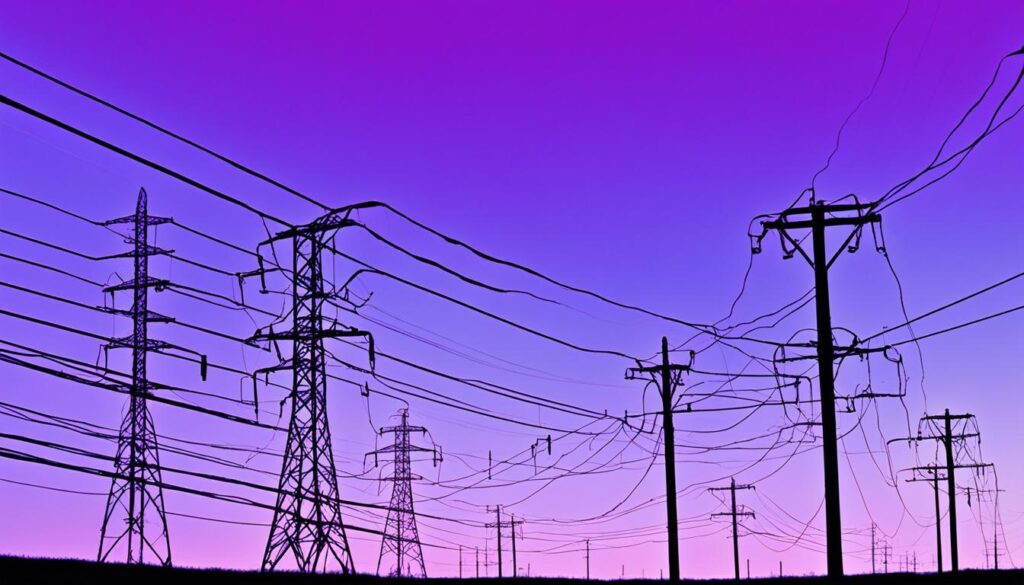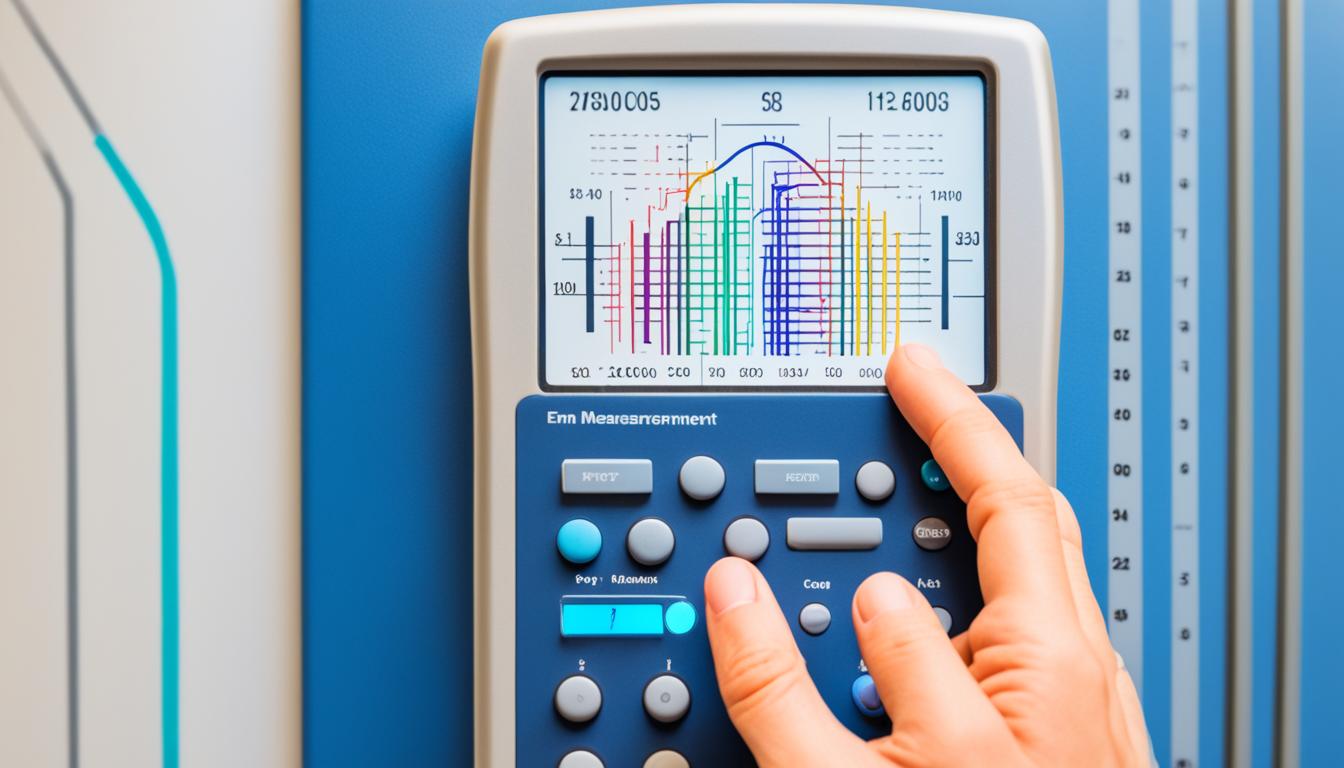Disclosure: This Post Contains Affiliate Links; We earn a commission on purchases.
Welcome to our comprehensive guide on electromagnetic fields (EMFs), the invisible forces that surround us in our modern world. In this article, we will delve into the basics of EMFs, their potential health effects, and how to protect ourselves from exposure. Whether you’re new to EMFs or looking to deepen your understanding, this article will provide you with valuable insights and practical tips for EMF awareness and safety.
EMFs are electromagnetic fields created by electric fields and magnetic fields. They exist around any electrical device, from our laptops to power lines. While some EMFs occur naturally, such as in the Earth’s magnetic field, others are a result of human activities, like the use of wireless communication devices.
Understanding EMFs is crucial for safeguarding our well-being. In this guide, we will explore the different types of electromagnetic fields, their strengths, and effects on our environment. We will also dive into the ongoing research on the health impacts of EMFs and provide strategies for creating a low-EMF environment at home.
So if you’re ready to demystify the world of EMFs and take control of your exposure, let’s dive in!
Key Takeaways:
- EMFs are invisible forces produced by electric and magnetic fields.
- They can occur naturally or result from human activities.
- Understanding different types of electromagnetic fields is crucial for navigating EMF exposure.
- Research on the health effects of EMFs is ongoing, and precautions should be taken to minimize exposure.
- Creating a low-EMF environment at home can help reduce potential risks.
Understanding Vector Fields and Invisible Forces
In order to comprehend the invisible forces that shape our world, it is crucial to understand vector fields, especially when it comes to electromagnetic fields (EMFs). Vector fields exist in a multitude of natural phenomena, from the majestic chaos of storm systems to the simple act of sitting in a chair. By delving into the intricacies of vector fields, we can gain a deeper understanding of the interconnectedness of electromagnetic forces in our environment.
Visualizing vector fields can be challenging, as these abstract concepts are expressed through mathematical equations. However, with the aid of specialized computer programs, these equations can be transformed into visual representations that help us grasp the nature of vector fields in the real world. These visualizations allow us to see the invisible, bringing clarity to the complex nature of electromagnetic forces.
“Vector fields are like the hidden tapestry of the universe, weaving together the intricate dance of invisible energies.”
By studying vector fields, we can gain insight into the behavior of electromagnetic fields. This knowledge empowers us to navigate and harness these invisible forces effectively, whether it be by developing technologies that utilize electromagnetic fields or implementing measures to mitigate potential health effects associated with EMF exposure.
Visualizing Vector Fields
The visualization of vector fields helps us to grasp the underlying patterns and dynamics at play. This can be accomplished through color maps, streamlines, or other graphical representations. Let’s take a look at an example of visualizing a vector field:
| Vector Field Example |
|---|
Understanding Electromagnetic Fields
Electromagnetic fields are a specific type of vector field, encompassing both electric and magnetic fields. These fields are generated by voltage and electric current, respectively. Electric fields are characterized by their strength and direction, measured in volts per meter (V/m). Magnetic fields, on the other hand, are measured in gauss (G) or tesla (T) and are created by the flow of electrical current. The combination of electric and magnetic fields forms the electromagnetic fields that surround us.
By deepening our understanding of vector fields and their connection to electromagnetic fields, we can navigate the invisible forces that shape our world. Let’s continue our exploration in the next section, where we will delve into the different types of electromagnetic fields and their effects.
The Different Types of Electromagnetic Fields
Electromagnetic fields (EMFs) come in various types categorized by their frequencies. Understanding these different types of EMFs can help us grasp their impact and take appropriate measures to mitigate potential risks.
Extremely Low Frequencies (ELF)
ELF fields are commonly associated with appliances and power lines. These frequencies are much lower than those used for communication purposes and are typically measured in hertz (Hz). Examples of appliances that emit ELF fields include refrigerators, televisions, and power tools.
High Frequencies (HF) and Low Frequencies (LF)
HF and LF fields are commonly associated with the transmission of radio signals. HF frequencies range from about 3 megahertz (MHz) to 30 MHz, while LF frequencies range from about 30 kilohertz (kHz) to 300 kHz. AM radio transmissions, which fall under the HF and LF range, are examples of fields produced by these frequencies.
Very Low Frequencies (VLF)
VLF fields are typically found in TVs and video display terminals. These frequencies range from about 3 kHz to 30 kHz. Although less commonly encountered in everyday life, VLF fields are still present in certain electronic devices.
Very High Frequencies (VHF)
VHF fields are associated with TV and FM radio transmissions. These frequencies range from about 30 MHz to 300 MHz. TV broadcasts and FM radio signals fall under this category of fields.
Super High Frequencies (SHF)
SHF fields are used in microwave ovens and operate at frequencies ranging from about 3 gigahertz (GHz) to 30 GHz. The high frequencies allow microwaves to heat food efficiently, as they are readily absorbed by water molecules.
The Different Types of Electromagnetic Fields at a Glance:
| Type of EMF | Frequency Range | Example |
|---|---|---|
| ELF | Extremely Low Frequencies | Appliances, power lines |
| HF and LF | High and Low Frequencies | AM radio transmission |
| VLF | Very Low Frequencies | TVs, video display terminals |
| VHF | Very High Frequencies | TV and FM radio transmission |
| SHF | Super High Frequencies | Microwave ovens |
Each category of electromagnetic fields operates at specific frequencies and has varying strengths and effects on our environment. Understanding these different types allows us to make informed decisions regarding our exposure and implement measures to reduce potential risks.
Next, we will explore the impact of EMFs on health and how to create an EMF sanctuary at home.

Electric and Magnetic Fields in the Environment
Electric fields and magnetic fields are two crucial components of electromagnetic fields (EMFs) that exist in our environment. Understanding their characteristics and sources is essential in comprehending EMF exposure and its potential impacts. Let’s delve deeper into the intricacies of electric and magnetic fields.
Electric Fields
Electric fields are generated by the presence of voltage and can be observed around any electrical device. The strength of the electric field increases as the voltage increases. Interestingly, electric fields can persist even when electrical equipment is switched off as long as they remain connected to a power source.
While electric fields are an inherent part of our modern infrastructure, they can also result from natural phenomena, such as during lightning strikes. However, it is important to note that the electric field strength diminishes with distance from the source.
Magnetic Fields
Magnetic fields, on the other hand, are produced by the flow of current through wires or electrical devices. These fields become stronger as the current increases. For example, when you turn on an appliance, the flow of electricity through the device creates a magnetic field around it.
Electric fields and magnetic fields are interrelated and interact with each other in various ways. The strength and characteristics of these fields depend on the voltage, current, and other environmental factors. It is important to consider both electric and magnetic fields when assessing EMF exposure.
One of the most common sources of electric and magnetic fields in our environment is power lines. These lines not only carry electrical power but also generate electric and magnetic fields due to the high voltages and currents involved.
Similarly, our everyday appliances, such as refrigerators, televisions, and computers, generate electric and magnetic fields, albeit at lower levels compared to power lines. Nonetheless, their continuous usage can contribute to overall EMF exposure.
Overall, being aware of electric fields and magnetic fields is crucial in understanding the nuances of EMF exposure. By recognizing the sources of electric and magnetic fields, such as power lines and appliances, we can take informed steps to minimize our exposure and create a safer living environment.
Stay tuned for the next section, where we will explore the impact of EMFs on our health and the importance of EMF protection.

The Impact of EMFs on Health
The impact of electromagnetic fields (EMFs) on health is a topic that continues to be researched and debated. While some studies suggest that long-term exposure to high levels of EMFs can have adverse health effects, including an increased risk of cancer, neurological disorders, and reproductive problems, other studies have not found conclusive evidence of these effects.
It is important to be aware of the potential risks associated with EMF exposure and take necessary precautions to protect ourselves and our loved ones.
One of the key concerns regarding EMF exposure is its potential link to cancer. Although studies have shown mixed results, a report by the International Agency for Research on Cancer (IARC) classified EMFs as “possibly carcinogenic to humans” based on limited evidence of their association with certain types of cancer.
To reduce exposure to EMFs and minimize potential health risks, consider the following precautionary measures:
- Limit the use of electronic devices, particularly those that emit high levels of EMFs, such as cell phones, laptops, and microwaves.
- Use EMF shielding products, such as radiation-blocking phone cases or laptop shields, to reduce your exposure to electromagnetic radiation.
- Create a low-EMF environment at home by keeping electronic devices at a distance, unplugging them when not in use, and using wired connections instead of Wi-Fi when possible.
- Utilize tools, such as apps or meters, to measure and monitor EMF levels in your environment.
By implementing these precautions, you can take proactive steps towards minimizing your exposure to EMFs and safeguarding your well-being.
“While the research surrounding the health effects of EMFs is still evolving, it’s always wise to err on the side of caution. By adopting simple lifestyle changes and investing in EMF protection, you can create a healthier living environment for yourself and your family.”
– Dr. Emily Thompson, Environmental Health Expert
It’s worth noting that individual sensitivity to EMFs can vary, with some people experiencing symptoms such as headaches, fatigue, or sleep disturbances in the presence of high levels of electromagnetic radiation. If you suspect you may be more sensitive to EMFs or are experiencing unexplained health issues, consider consulting a medical professional or an EMF specialist who can provide further guidance and support.
Remember, staying informed about EMFs, taking necessary precautions, and seeking professional advice can help you make informed decisions and prioritize your health and well-being in our increasingly connected world.
| EMF Health Effects | Symptoms |
|---|---|
| Cancer | Increased risk of certain types of cancer |
| Neurological Disorders | Headaches, sleep disturbances, cognitive impairment |
| Reproductive Problems | Reduced fertility, adverse pregnancy outcomes |
| Electrosensitivity | Fatigue, dizziness, skin rashes |
Creating an EMF Sanctuary at Home
Minimizing your exposure to electromagnetic fields (EMFs) and creating a low-EMF environment in your home is essential for maintaining a safer and healthier living space. By implementing the following measures, you can significantly reduce your overall EMF exposure:
- Utilize EMF shielding products: EMF shielding is a proven method to reduce exposure to electromagnetic radiation. Products such as shielding paint, curtains, and fabrics can create a barrier between you and EMFs.
- Rearrange furniture strategically: Place your furniture in a way that reduces proximity to electronic devices, power outlets, and appliances. This can help minimize your exposure to EMFs while you go about your daily activities.
- Opt for wired connections: Whenever possible, choose wired connections for your devices instead of relying on wireless technology. Using ethernet cables instead of Wi-Fi connections can significantly reduce EMF exposure from routers and other wireless devices.
- Create a sleep sanctuary: Your bedroom is a crucial area where you should prioritize reducing EMF exposure. Consider using an RF shielded bed canopy to create a low-EMF environment that promotes better sleep and rejuvenation.
Implementing these strategies will help you create an EMF sanctuary at home, where you and your loved ones can thrive in a low-EMF environment.
| Product | Description | Benefits |
|---|---|---|
| EMF shielding paint | A special paint containing metal particles that reflect and absorb EMFs. | Creates a protective barrier on walls and ceilings, reducing EMF penetration. |
| EMF shielding curtains | Curtains made of conductive fabric that block or reduce EMF radiation. | Offers privacy and protection from EMF exposure, especially near windows. |
| EMF shielding fabrics | Specialized textiles that can be used to make curtains, bed canopies, and clothing. | Provides a versatile solution for reducing EMF exposure in various applications. |
Note: Consult with professionals or experts in the field to determine the most suitable EMF shielding products for your specific needs and situation.
Seeking Professional EMF Guidance
If you feel overwhelmed or unsure about how to navigate EMF exposure and protection, seeking guidance from a professional EMF consultant can be beneficial. An EMF consultant can assess the EMF levels in your home, provide recommendations for remediation, and guide you in creating a low-EMF environment.
They can also help individuals with EMF sensitivities understand their exposure risks and provide strategies for minimizing their symptoms. By working with an expert in the field, you can gain personalized guidance and support in reducing your exposure to harmful man-made electromagnetic radiation.
| Benefits of Hiring an EMF Consultant | How an EMF Consultant Can Help |
|---|---|
| Expert knowledge and experience | Assessing EMF levels in your home |
| Personalized guidance and support | Providing recommendations for remediation |
| Understanding of EMF sensitivities | Guiding you in creating a low-EMF environment |
| Minimizing risks and symptoms | Developing strategies for EMF sensitivities |
Remember, reducing your exposure to harmful EMFs is essential for maintaining a healthy and balanced life. Consulting with an EMF expert can give you the peace of mind and knowledge you need to protect yourself and your loved ones.
Testimonial: A Journey to EMF Freedom
“I had been experiencing unexplained health issues for months, and I suspected that EMFs might be the culprit. I decided to reach out to an EMF consultant for guidance. With their help, I learned about the sources of high EMF levels in my home and received practical solutions to reduce my exposure. Not only did I regain my health, but I also gained invaluable knowledge about EMF safety. I highly recommend seeking professional EMF guidance to anyone concerned about the potential health risks associated with electromagnetic radiation.”
By consulting with an experienced EMF consultant and implementing their recommendations, you can take proactive steps towards creating a safer and healthier environment for yourself and your family.
Conclusion
In conclusion, understanding the basics of EMFs is crucial for safeguarding ourselves and our loved ones from the invisible electromagnetic fields that surround us. By being aware of the different types of electromagnetic fields and their potential health effects, we can take proactive steps to ensure EMF safety and protection.
Creating a low-EMF environment is an important aspect of minimizing EMF exposure. This can be achieved through various measures, such as using EMF shielding products, rearranging furniture to reduce proximity to electronic devices, and opting for wired connections whenever possible. By implementing these strategies, we can reduce our overall EMF exposure and create a safer and healthier living environment.
However, if you find navigating EMF exposure and protection daunting, seeking guidance from a professional EMF consultant can be of great help. An EMF consultant can assess the levels of EMFs in your home, provide personalized recommendations for remediation, and guide you in creating a low-EMF environment tailored to your specific needs.
Remember, EMF awareness and protection are vital for maintaining a healthy and balanced life in today’s modern world. By staying informed and taking necessary precautions, we can mitigate potential health risks associated with EMF radiation and ensure a safer and more harmonious environment for ourselves and future generations.
Source Links
- https://www.abc.net.au/science/articles/2005/04/11/1342558.htm
- https://podcasts.apple.com/il/podcast/emf-remedy/id1652241197
- http://www.cpuc.ca.gov/Environment/info/esa/lakeville/fmnd/6b-AppendixB-EMF.pdf

Subscribe to Our Newsletter










